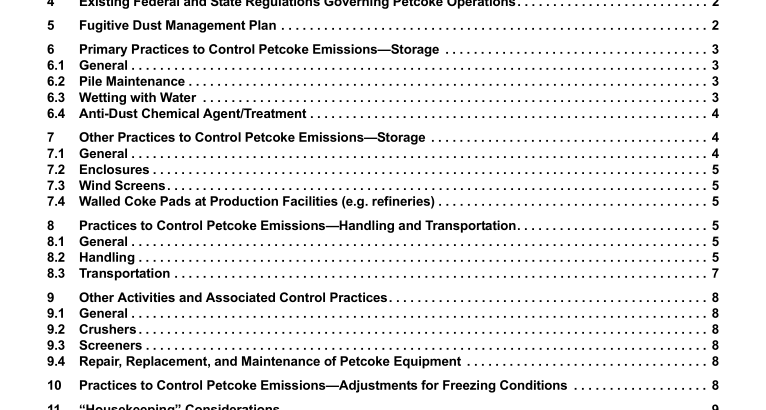API GD PC1:2014 pdf free download.Guidance Document for the Storage and Handling of Petroleum Coke
The application method for water during petcoke handling will be determined by the logistics of the transfer operation, product specific variables, and operating permit conditions. For example, transfer points where petcoke is being transferred from one conveyor to another may utilize a water spray bar or misting system.
To help mitigate fugitive dust emissions, particular areas of the petcoke handling system should employ a wetting dust suppression system. Dust suppression points that should be considered include:
— Conveyors [Configurations (uncovered, covered, enclosed, half-moon, tube) and Transfer Points (use of bag houses, water sprays)] Configurations for conveyor systems used to transfer petcoke include uncovered, covered, enclosed, half-moon, or tube styles. At each transfer point within the conveyer system, a wetting fugitive dust suppression measure — or in the case of an enclosed transfer point, a bag house—should be considered. Transfer of “moist” material can be considered as a fugitive dust control measure. Because petcoke is hydrophobic, additional moisture can typically be applied without impacting product quality while improving the operator’s ability to transfer and handle the material without creating fugitive dust emissions.
The moisture content level required for fugitive dust control is dependent on the properties of the material and should be understood by the operator for specific products and operations. Accordingly, the use of water sprays or water cannons should be considered prior to loading petcoke onto conveyors if the moisture content of the petcoke is low. Wetting also should be considered along the conveyor route.
Moist petcoke tends to promote more evenly distributed loading across the conveyor belt, which further reduces chances of spillage and dust creation. In addition, water application at the transfer points can help address the issue of petcoke “drying up” as it gets transported from belt to transfer point and onto the next belt, several times on a long conveyor run. For example, one facility has a belt train that is over 2 miles long and two of the eleven transfer stations are equipped with water spray systems that help keep the coke moist before it gets transported further downstream.
Another configuration is where the conveyor belts are housed in “galleries” which can significantly reduce the amount of fugitive dust emissions to the atmosphere since most of it is contained within the gallery structure. Frequent conveyor monitoring and maintenance is recommended to ensure a reliable system with minimal spillage/carryback and reduced fugitive dust emissions.
Minor adjustments and maintenance (such as re-aligning a belt, replacing idler pulleys, adjusting transfer station belt scrapers, etc.) may frequently be needed and contribute towards minimizing downtime and repairs.
— Loading and Unloading Practices Truck loading and unloading should be conducted so as to minimize the potential generation of fugitive dust. Steps may include:
— applying water to product being loaded or unloaded,
— minimizing drop distances.
8.3 Transportation In addition to the storage and handling guidance provided above, sites should take steps to minimize fugitive dust emissions generated during on-site activities related to transportation. Trucks leaving the premises should be cleaned and steps should be taken to ensure the petcoke loads are appropriately covered or wetted, with consideration given to treating with anti-dust chemical agent to prevent emissions. Specific steps to consider include, but are not limited the following.
— Site speed limits—restrict to an appropriate limit for site such that fugitive dust is not created.
— Use of speed bumps to manage speed of transport vehicles.
— Enforce on-site speed limits to minimize stirring up petcoke fugitive dust.
— Truck trailers
— After loading, if the petcoke is leaving the site, the transportation company should take the appropriate steps to manage potential fugitive dust emissions.
— Truck trailer tops may be covered with a tarp after being loaded.API GD PC1 pdf download.API GD PC1:2014 pdf free download
